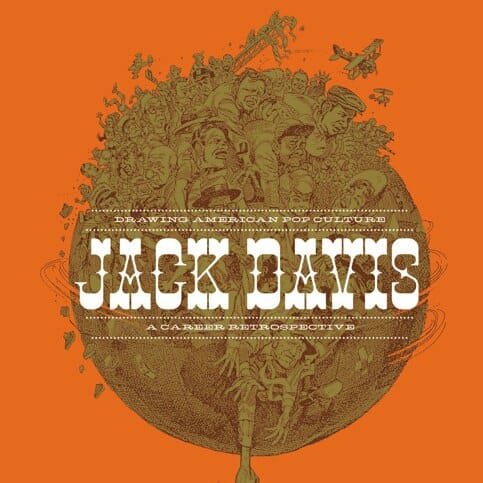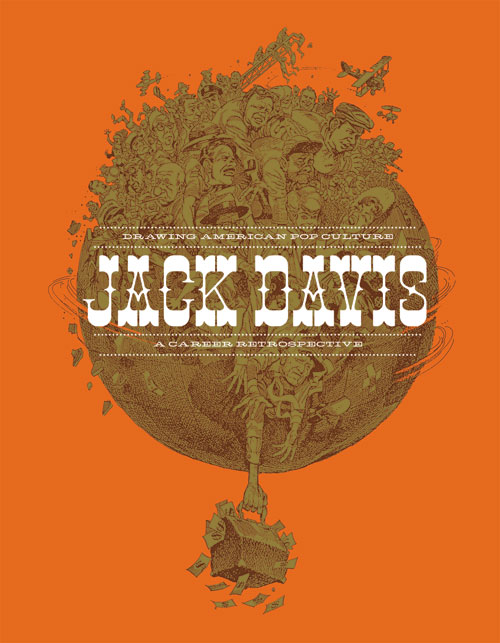
Each week, Paste reviews the most intriguing comic books, graphic novels, graphic memoirs and other illustrated books.

Jack Davis: Drawing American Pop Culture: A Career Retrospective
by Jack Davis
Fantagraphics, 2011
Rating: 8.2
The only real problem with this beautifully produced book is that it’s much, much too short. If anything, it gives a sampling of the work for which the renowned illustrator is known, skipping from his earliest cartoons (which he published at the age of 14) to his collegiate work, his military work, his album covers and movie posters, his drawings for EC Comics and Mad, and fitting all that in a relatively slim 208 pages. The art reproduces gorgeously, scanned in many cases from the original material, and the volume as a whole is an effort to give Davis the respect he deserves as a legitimate artist. Sure, he’s popularly beloved, and his work is on every other wall in Athens, Ga., but he doesn’t garner the same garlands as, say, Art Spiegelman, probably because he’s really a pure illustrator and not a writer. A few essays, slotted at the front and back of the back, rather than next to the art itself, place him in context and give some biographical details, but the work, with Davis’s fluid, effortless line and gift for characterization, speaks for itself. (HB)

Deadpool MAX X-Mas
by David Lapham, Kyle Baker, Shawn Crystal and Lee Loughride
Marvel, 2011
Rating: 4.3 **
Does anyone remember Jason Aaron’s Punisher MAX Christmas Special from 2008? If you have it, reread it. If you don’t, find it. Just don’t pick up Marvel’s latest ironic attempt to usher the holidays in with another homicidal antihero. Deadpool has fit the MAX universe well, filling his pages with subversive cartoon insanity penciled by Kyle Baker, comicdom’s very own Tex Avery. Writer David Lapham fills the hole Garth Ennis left at Marvel, delivering fecal puns, severed limbs and sex jokes that would only be funny to people who haven’t had it. And, for what it is, his work usually delivers. This $5 Christmas special had the potential to skewer the kitsch of Americana’s most profitable religious gala, but instead resorts to a rushed cash-in. The exposition’s great: ludicrous mercenary Deadpool shows his government handler Bob how important he is by stealing a corpse and pumping it full of Bob’s blood, releasing the body to the media so the world believes his partner’s dead. Cynical to a fault, Bob observes his loved ones celebrating his demise. Call me jaded, but watching a character listen to how hated he is for three acts doesn’t exploit a book about an immortal mutant ninja to its fullest potential. Lapham and Baker illustrate a third of the book followed by Lee Louhride for the finale. All are equally boring. Those who were looking for a showdown with Santa, a visitation from three 90’s X-Force ghosts or any other genre-bending holiday fun are going to be disappointed, because this misfire belongs with the coal. (SE)

The Someday Funnies
edited by Michel Choquette
**Abrams, 2011
Rating: 7.1
This book is a handful—several handfuls, in fact. Printed as a hardback at full tabloid size (11 ½ x 15 ½ inches), it’s damn difficult to read without poking yourself somewhere uncomfortable. Its project, too, encompasses much and is complex to explain briefly. Basically, in the early 1970s Choquette recruited a ton of artists and writers from around the globe to express something about the 1960s in comics format, originally to be published in Rolling Stone. It didn’t work out, and he schlepped the pages around for years, rejected at every turn. This year is the first time they’ve seen print, thanks to great enthusiasm by Abrams. The question is whether it even works as a book anymore. There are great contributions here, including many by boldface names (Jack Kirby, Don Martin, Sergio Aragones, Art Spiegelman, Joost Swarte, Will Eisner), some of whom aren’t known for comics (Tom Wolfe, Frank Zappa, Federico Fellini), and the net is positive, but who cares about the 1960s these days? Sure, it’s kind of like being plunged back into still sharp-edged nostalgia, and there are plenty of interesting details or strips that work well on their own, but the overall product is as unwieldy as its format. What do you expect when you try to cram a decade into a mere 216 pages, many of which are taken up with explanations of the project? Still, it’s worth picking up for browsing, which probably works better than trying to read the thing straight through, and it works well as a treasury of unpublished material. (HB)

Hellblazer Annual 2011: Suicide Bridge
by Peter Milligan and Simon Bisley
Vertigo Comics, 2011
Rating: 4.5
You’d think a comic approaching its 300th issue would be as listless and desiccated as the last decade of Ken Griffey Jr.’s career, but Hellblazer has rediscovered its swing since Peter Milligan took over in 2008. Like the regular series, which often pits the now AARP-aged John Constantine against a lamentable relic from his past, this annual focuses on a childhood friend who disappeared in 1968. This double-sized story lacks the spark of the on-going, replacing the melancholy weight of Constantine’s sordid sixty years with a drab afterschool special about teen runaways and soul-devouring ghost bridges. Okay, that last part sounds awesome, but Milligan’s approach is tired and predictable, with little of the dark wit of the longer stories serialized in Hellblazer. Constantine’s young wife Epiphany barely appears and thus is missed; a character that could easily be a fan-service mannequin (she is a sexy young goth alchemist who looks like a Suicide Girl, after all) instead is one of the stronger and more believable women characters in comics today. That isn’t that surprising, though, as Milligan’s best characters tend to be female, from Kathy and Lenny in Shade, the Changing Man to Edie in X-Statix. Bisley’s art is the highlight, but it curdles in an almost impenetrably dark color palette that makes even the brown of Constantine’s coat and the yellow of his hair look like variations on grey and white. Suicide Bridge is a rare misstep from one of the better monthlies currently on the market. (GM)